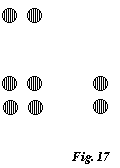CONSTRUCTION VIII. THE SHAFT 131
being used, both with quatrefoil sections. The plain double shaft, however, is by far the most frequent, both in the Northern and Southern Gothic, but for the most part early; it is very frequent in cloisters; and in the singular one of St. Michael’s Mount, Normandy, a small pseudo-arcade runs along between the pairs of shafts, a miniature aisle. The group is employed on a magnificent scale, but ill-proportioned, for the main piers of the apse of the cathedral of Coutances, its purpose being to conceal one shaft behind the other, and make it appear to the spectator from the nave as if the apse were sustained by single shafts of inordinate slenderness. The attempt is ill-judged, and the result unsatisfactory.
§ 28. (2.) When these pairs of shafts come near each other, as frequently at the turnings of angles (Fig. 17), the quadruple group results, b 2, Fig. 14, 
§ 29. (3.) Such groups, consolidated by a small square in their centre, from the shafts of St. Zeno, just spoken of, and figured in Plate 17, which are among the most interesting pieces of work I know in Italy. I give their entire arrangement on the next page at the side, Fig. 18:1 both shafts have the same section, but one receives a half turn as it ascends,
* The largest I remember support a monument in St. Zeno of Verona: they are of red marble, some ten or twelve feet high.
1 [See above, Introduction, p. xxxiii., for a reference to this figure. In the additional matter there mentioned, Ruskin says:-
“At the 100th page of Mr. Street’s Brick and Marble Architecture of Italy he has given a drawing of two pillars in San Zenone of Verona. Four years previously I had engraved the same two pillars in the 17th plate of the first volume of The Stones of Venice. It is quite worth the reader’s while to take some pains to compare the two plates, and as he will find considerable differences between them, I will give in full the notes on which my own drawing was founded, merely engraving the rough sketches made on the spot in facsimile. [These sketches were not, however, engraved, and they
[Version 0.04: March 2008]